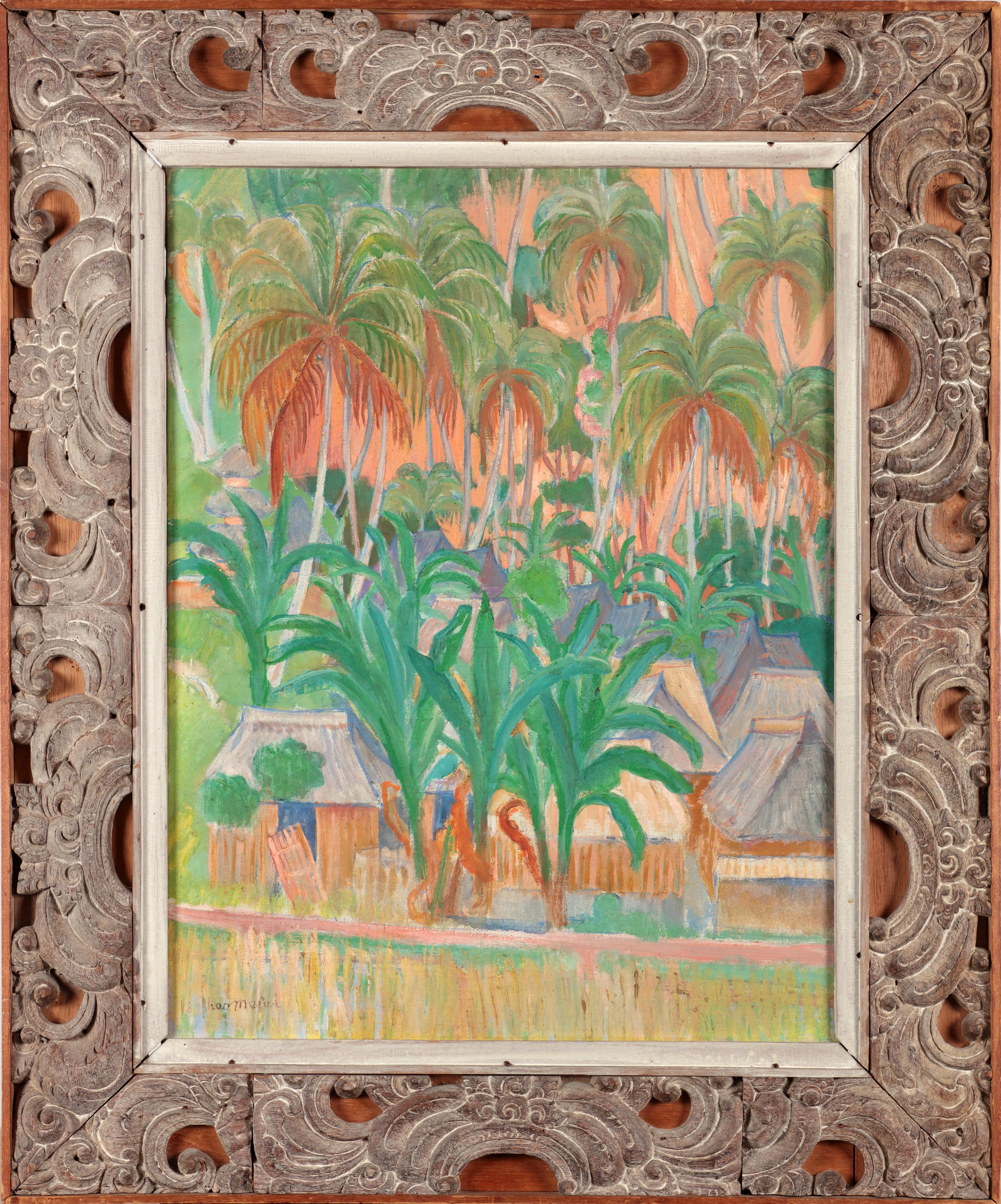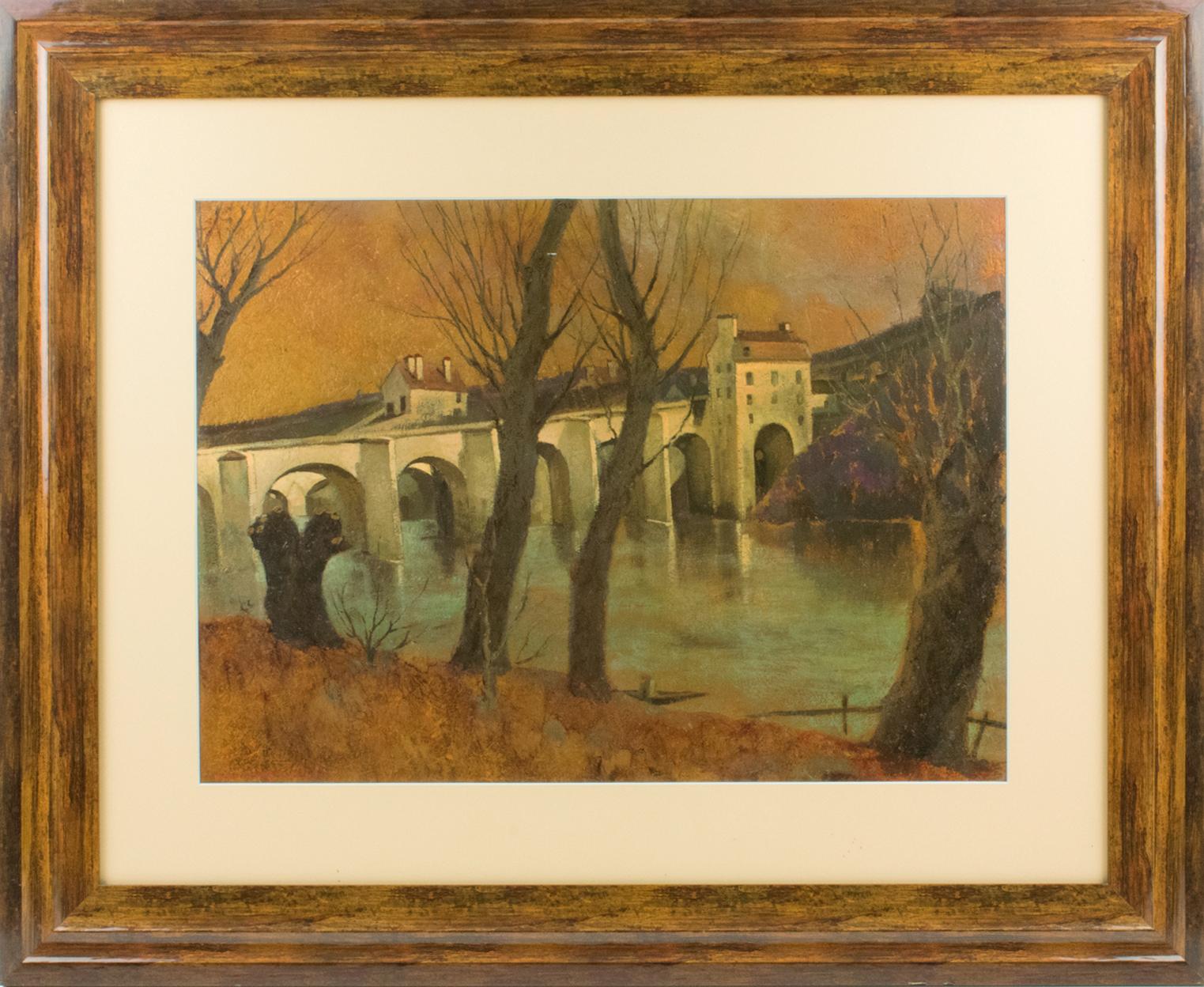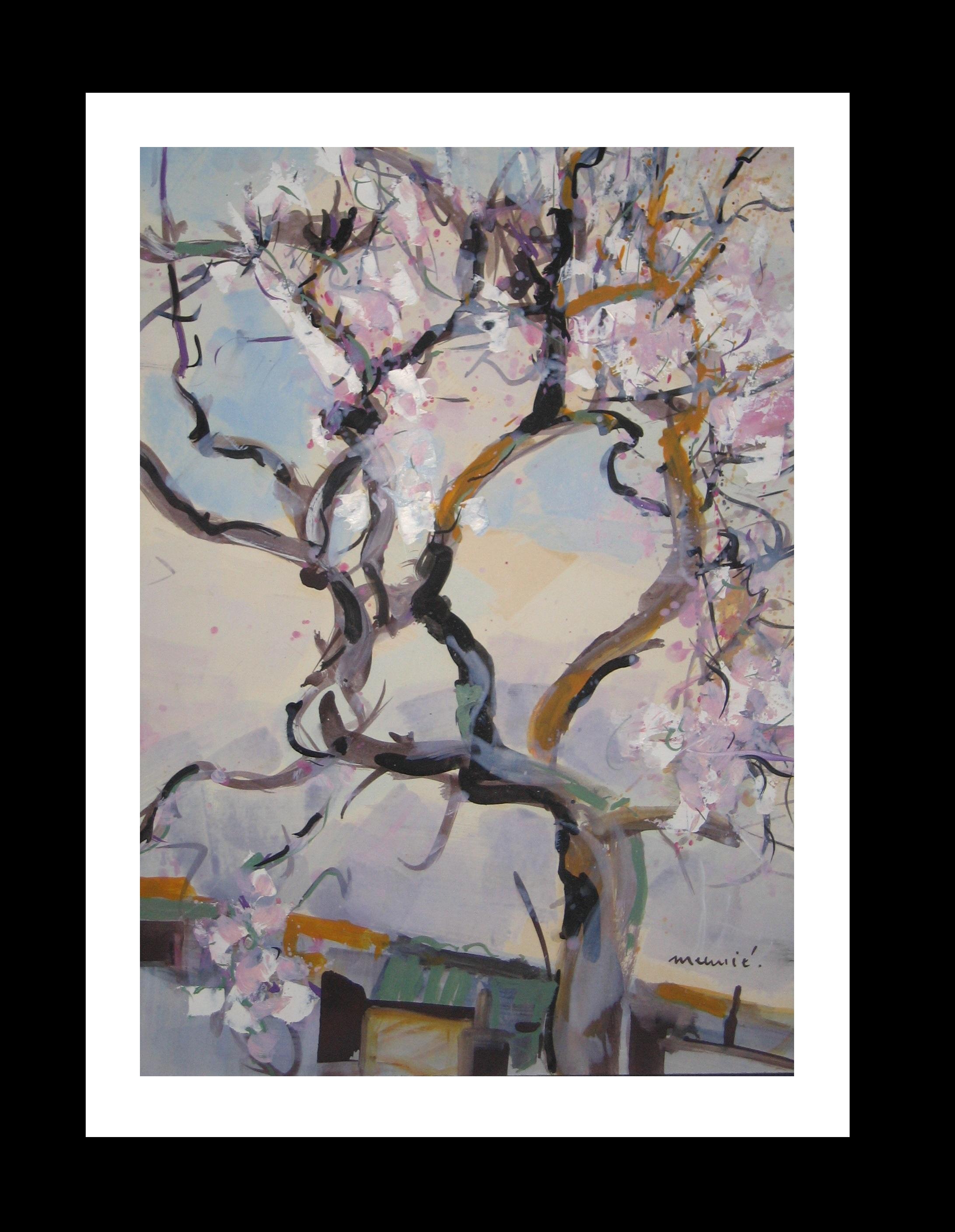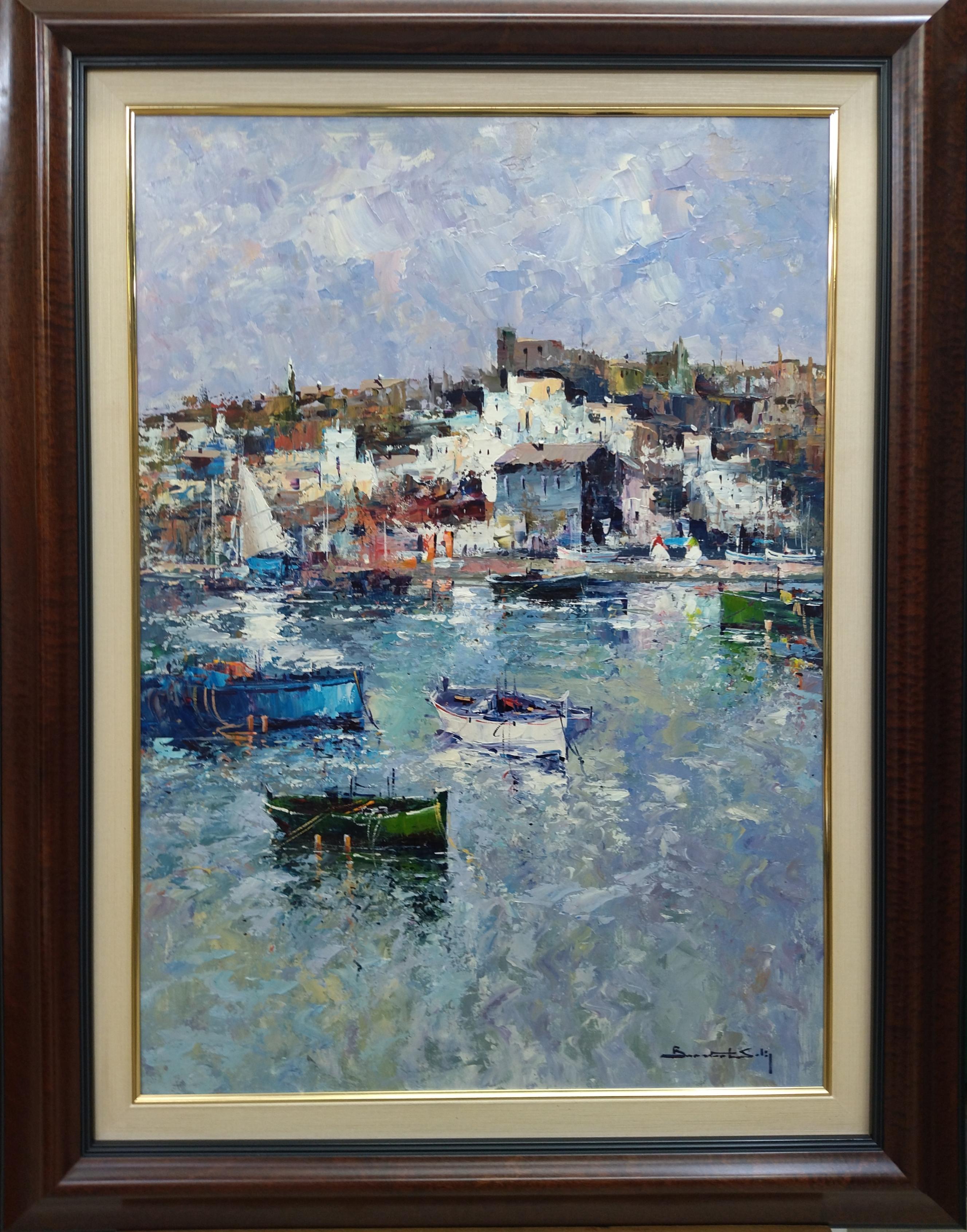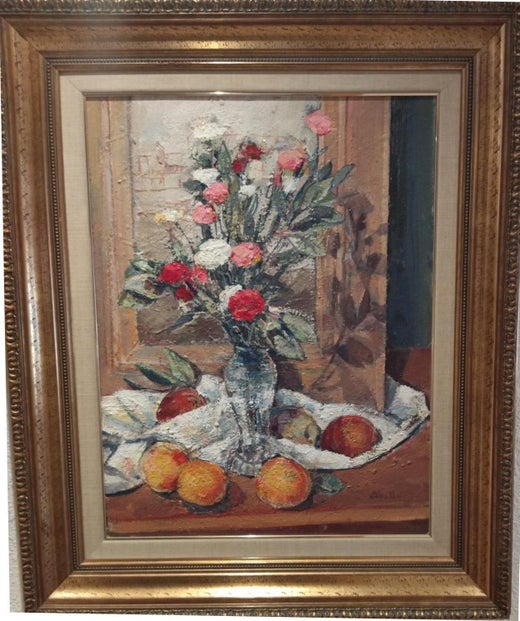Juan Jose Abella Rubio Abella Town Street Original landscape Cubist acrylic painting1994
1994
About the Item
- Creator:Juan Jose Abella Rubio (1944, Spanish)
- Creation Year:1994
- Dimensions:Height: 21.26 in (54 cm)Width: 26.78 in (68 cm)Depth: 0.4 in (1 cm)
- Medium:
- Movement & Style:
- Period:
- Condition:
- Gallery Location:CORAL GABLES - MIAMI, FL
- Reference Number:1stDibs: LU471313007032
Juan Jose Abella Rubio
Juan Jose Abella Rubio was born in Estercuel, a hamlet anchored in the Teruel mining basin in March 1944. In 1956, he was in Pont d'Inca (Mallorca), studying baccalaureate and magisterium, at the same time that he graduates in artistic drawing and publicity with outstanding. In 1970, he moved to Barcelona. Abella Rubio studied at the Universidad Central, graduating with an outstanding study of the provisional architecture, The Tomb of Charles V in Valladolid, which would later be published by the Higher Council of Scientific Research. He completed his training with Fine Arts at the Superior School of Fine Arts in Barcelona. Abella Rubio has held exhibitions in Florida, Amsterdam, Barcelona, Madrid, Mallorca and Plasencia. His paintings can be seen in the Hispanic American Fund of the Florida Museum, as well as in the monasteries of the Olivar (Teruel) and San Ramón (Lérida), the Jesus, Maria and José (Barcelona), the Europa International School and Ágora Sant (Cugat) and various private collections. His drawings have been published by Art Reproduction Mollori and the Editorial Messeguer. He has also painted murals in the Agora, Bernat el Ferrer (Molins de Rei) and Can Peixauet (Santa Coloma de Gramenet) schools.

- ShippingRetrieving quote...Ships From: CORAL GABLES - MIAMI, FL
- Return PolicyA return for this item may be initiated within 3 days of delivery.
- J. Meunie 28 Tree Almond Blossom Vertical original acrylic paintingBy Julen MeunieLocated in CORAL GABLES - MIAMI, FL" ALMOND BLOSSOM original acrylic painting. framed Julien was born in 1948 in Vichy, France. He studied art and theater in Clermont-Ferrand at the same time as finishing his degree ...Category
Late 20th Century Expressionist Landscape Paintings
MaterialsWood, Oil
- Benavente Solís . Landscape - original expressionistBy Benavente SolisLocated in CORAL GABLES - MIAMI, FLLandscape original expressionist painting. frame Work of the Spanish artist BENAVENTE SOLIS. Perfect state . During its first exhibition in Paris, the French press catalogs it lik...Category
1990s Expressionist Landscape Paintings
MaterialsOil, Wood
- J. Meunie 28 Tree Almond Blossom Vertical original acrylic paintingBy Julen MeunieLocated in CORAL GABLES - MIAMI, FL" ALMOND BLOSSOM original acrylic painting. framed Julien was born in 1948 in Vichy, France. He studied art and theater in Clermont-Ferrand at the same time as finishing his degree ...Category
Late 20th Century Expressionist Landscape Paintings
MaterialsOil, Wood
- Meneses. MAJORCA. square. LANDSCAPE- original acrylic wodd paintingBy Josep MenesesLocated in CORAL GABLES - MIAMI, FLMAJORCA. LANDSCAPE- original acrylic wodd painting. This Catalan painter, settled for years in Mallorca, offers a series of landscapes in which the natural is treated in the impress...Category
Late 20th Century Expressionist Landscape Paintings
MaterialsWood, Oil
- Copons PARIS.RIVER. BRIDGE.SENA . Landscape original acrylic canvas paintingBy Joan CoponsLocated in CORAL GABLES - MIAMI, FLOriginal work by the Spanish artist Joan COPONS. Oil on canvas . Perfect stateCategory
Late 20th Century Expressionist Landscape Paintings
MaterialsCanvas, Oil
- Luis Amer "BARCELONA I" original expressionist acrylic paintingBy Luis AmerLocated in CORAL GABLES - MIAMI, FLIn this colorist work we see reflected the Spanish expressionism, being AMER one of its maximum representatives. AMER, Luis (Barcelona, 1943).. Luis Amer graduated in Barcelona, at...Category
21st Century and Contemporary Expressionist Landscape Paintings
MaterialsCanvas, Oil
- Village of Iseh, Bali (1948)By Theo MeierLocated in Amsterdam, NLTheo Meier (1908-1982) View of the Village of Iseh, painted from the house of Theo Signed and dated 48 Theo Meier lower left Oil on canvas, 68.5 x 50 cm In original frame carved by the artist. Note: Theo Meier arrived in Bali in 1936 with the intention of going on to Tahiti where he had been before. However Bali turned out to be the paradise he had been searching for in his dreams and he had no desire any more to move elsewhere. Bali at that time was still a very traditional place where society lived according to an acient religious system and in a luscious tropical setting the modern world was ignored. Here he met Walter Spies...Category
Mid-20th Century Expressionist Landscape Paintings
MaterialsCanvas, Rosewood, Oil
- Vaulted Bridge in French Landscape Oil on Wood Painting by Vincent MazzocchiniLocated in Atlanta, GAVincent Mazzocchini (France, 20th Century) created this unique French landscape oil on pressed wood board painting. This delightful composition is on rather unusual media. The lands...Category
1940s Expressionist Landscape Paintings
MaterialsWood, Masonite, Oil
- "Mexican Countryside Landscape Mountain Scene with Trees" Expressionistic StyleBy Michael BaxteLocated in New York, NYA strong modernist oil painting depicted in 1962 by Russian painter Michael Baxte. Mostly known for his abstracted figures on canvas or street scenes, this piece is a wonderful repre...Category
1960s Expressionist Landscape Paintings
MaterialsMasonite, Oil
- "Landscape Scene of Mexican Villagers" Expressionistic Oil Painting on MasoniteBy Michael BaxteLocated in New York, NYA strong modernist oil painting depicted in 1971 by Russian painter Michael Baxte. Mostly known for his abstracted figures on canvas or street scenes, this piece is a wonderful representation of his landscape paintings, with expressive use of color, shape, and form. Later in his career, Baxte explores Expressionism, infusing both European and North American stylistic trends. This piece is from later in his career, but we can feel this underlying style throughout. Art measures 18 x 21.75 inches Michael Posner Baxte was born in 1890 in the small town of Staroselje Belarus, Russia. For the first half of the 19th century it was a center of the Chabad movement of Hasidic Jews, but this group was gone by the middle of the 19th century. By the time the Baxte family immigrated to the United States at the beginning of the 20th century, the Jewish population numbered only on the hundreds. The native language of the Baxte family was Yiddish. It is likely that the death of Michael Baxte’s father triggered the family’s immigration. Three older brothers arrived in New York between 1903 and 1905. Michael and his mother, Rebecca, arrived in 1907. By 1910 Michael, his mother, and brother, Joseph, were living in New Orleans and may have spent some time on a Louisiana plantation. Around 1912, Michael Baxte returned to Europe to study the violin. In 1914 he, his mother, and Joseph moved to New York City. Meanwhile, in Algeria, a talented young woman painter, Violette Mege, was making history. Since for the first time, a woman won the prestigious Beaux Art competition in Algeria. At first, the awards committee denied her the prize but, with French government intervention, Mege eventually prevailed. She won again 3 years later and, in 1916, used the scholarship to visit the United States of America. When Violette came to New York, she met Baxte, who was, by then, an accomplished violinist, teacher, and composer. Baxte’s compositions were performed at the Tokyo Imperial Theater, and in 1922 he was listed in the American Jewish Yearbook as one of the prominent members of the American Jewish community. As a music teacher he encouraged individual expression. Baxte stated, “No pupil should ever be forced into imitation of the teacher. Art is a personal experience, and the teacher’s truest aim must be to awaken this light of personality through the patient light of science.” By 1920 Michael Baxte and Violette Mege were living together in Manhattan. Although they claimed to be living as husband and wife, it seems that their marriage did not become official until 1928. On their “unofficial” honeymoon around 1917, in Algiers, Baxte confided to her his ambition to paint. There and later in New Mexico where the wonderful steeped sunlight approximates the coloring of Algiers, she taught him his heart’s desire. He never had any other teacher. She never had any other pupil. For ten years she devoted all her time, energy, and ambition to teaching, encouraging, inspiring him. Then in 1928, their mutual strivings were rewarded, as his works were being chosen as one of the two winners in the Dudensing National Competition for American Painters. Out of 150 artists from across the country participated in the Dudensing, and Michael Posner Baxte and, Robert Fawcett, were the winners. In his 1924 naturalization application, he indicated that he was sometimes known as “Michael Posner Baxte.” One of the witnesses to his application was Bernard Karfiol, a Jewish American artist. That’s when Michael may...Category
1960s Expressionist Landscape Paintings
MaterialsMasonite, Oil
- "Colorful Mexican Village Scene" Expressionistic Oil Painting on MasoniteBy Michael BaxteLocated in New York, NYA strong modernist oil painting depicted Circa 1960 by Russian painter Michael Baxte. Mostly known for his abstracted figures on canvas or street scenes, this piece is a wonderful representation of his bold still life paintings, with expressive use of color, shape, and form. Later in his career, Baxte explores Expressionism, infusing both European and North American stylistic trends. This piece is from later in his career, but we can feel this underlying style throughout. Art measures 18 x 21.75 inches Michael Posner Baxte was born in 1890 in the small town of Staroselje Belarus, Russia. For the first half of the 19th century it was a center of the Chabad movement of Hasidic Jews, but this group was gone by the middle of the 19th century. By the time the Baxte family immigrated to the United States at the beginning of the 20th century, the Jewish population numbered only on the hundreds. The native language of the Baxte family was Yiddish. It is likely that the death of Michael Baxte’s father triggered the family’s immigration. Three older brothers arrived in New York between 1903 and 1905. Michael and his mother, Rebecca, arrived in 1907. By 1910 Michael, his mother, and brother, Joseph, were living in New Orleans and may have spent some time on a Louisiana plantation. Around 1912, Michael Baxte returned to Europe to study the violin. In 1914 he, his mother, and Joseph moved to New York City. Meanwhile, in Algeria, a talented young woman painter, Violette Mege, was making history. Since for the first time, a woman won the prestigious Beaux Art competition in Algeria. At first, the awards committee denied her the prize but, with French government intervention, Mege eventually prevailed. She won again 3 years later and, in 1916, used the scholarship to visit the United States of America. When Violette came to New York, she met Baxte, who was, by then, an accomplished violinist, teacher, and composer. Baxte’s compositions were performed at the Tokyo Imperial Theater, and in 1922 he was listed in the American Jewish Yearbook as one of the prominent members of the American Jewish community. As a music teacher he encouraged individual expression. Baxte stated, “No pupil should ever be forced into imitation of the teacher. Art is a personal experience, and the teacher’s truest aim must be to awaken this light of personality through the patient light of science.” By 1920 Michael Baxte and Violette Mege were living together in Manhattan. Although they claimed to be living as husband and wife, it seems that their marriage did not become official until 1928. On their “unofficial” honeymoon around 1917, in Algiers, Baxte confided to her his ambition to paint. There and later in New Mexico where the wonderful steeped sunlight approximates the coloring of Algiers, she taught him his heart’s desire. He never had any other teacher. She never had any other pupil. For ten years she devoted all her time, energy, and ambition to teaching, encouraging, inspiring him. Then in 1928, their mutual strivings were rewarded, as his works were being chosen as one of the two winners in the Dudensing National Competition for American Painters. Out of 150 artists from across the country participated in the Dudensing, and Michael Posner Baxte and, Robert Fawcett, were the winners. In his 1924 naturalization application, he indicated that he was sometimes known as “Michael Posner Baxte.” One of the witnesses to his application was Bernard Karfiol, a Jewish American artist. That’s when Michael may...Category
1960s Expressionist Landscape Paintings
MaterialsMasonite, Oil
- "Landscape Scene of Fisherman by Lake" Expressionistic Oil Painting on MasoniteBy Michael BaxteLocated in New York, NYA strong modernist oil painting depicted in 1963 by Russian painter Michael Baxte. Mostly known for his abstracted figures on canvas or street scenes, this piece is a wonderful representation of his figures in water landscapes with expressive use of color, shape, and form. Later in his career, Baxte explores Expressionism, infusing both European and North American stylistic trends. This piece is from later in his career, but we can feel this underlying style throughout. Art measures 18 x 21.75 inches Michael Posner Baxte was born in 1890 in the small town of Staroselje Belarus, Russia. For the first half of the 19th century it was a center of the Chabad movement of Hasidic Jews, but this group was gone by the middle of the 19th century. By the time the Baxte family immigrated to the United States at the beginning of the 20th century, the Jewish population numbered only on the hundreds. The native language of the Baxte family was Yiddish. It is likely that the death of Michael Baxte’s father triggered the family’s immigration. Three older brothers arrived in New York between 1903 and 1905. Michael and his mother, Rebecca, arrived in 1907. By 1910 Michael, his mother, and brother, Joseph, were living in New Orleans and may have spent some time on a Louisiana plantation. Around 1912, Michael Baxte returned to Europe to study the violin. In 1914 he, his mother, and Joseph moved to New York City. Meanwhile, in Algeria, a talented young woman painter, Violette Mege, was making history. Since for the first time, a woman won the prestigious Beaux Art competition in Algeria. At first, the awards committee denied her the prize but, with French government intervention, Mege eventually prevailed. She won again 3 years later and, in 1916, used the scholarship to visit the United States of America. When Violette came to New York, she met Baxte, who was, by then, an accomplished violinist, teacher, and composer. Baxte’s compositions were performed at the Tokyo Imperial Theater, and in 1922 he was listed in the American Jewish Yearbook as one of the prominent members of the American Jewish community. As a music teacher he encouraged individual expression. Baxte stated, “No pupil should ever be forced into imitation of the teacher. Art is a personal experience, and the teacher’s truest aim must be to awaken this light of personality through the patient light of science.” By 1920 Michael Baxte and Violette Mege were living together in Manhattan. Although they claimed to be living as husband and wife, it seems that their marriage did not become official until 1928. On their “unofficial” honeymoon around 1917, in Algiers, Baxte confided to her his ambition to paint. There and later in New Mexico where the wonderful steeped sunlight approximates the coloring of Algiers, she taught him his heart’s desire. He never had any other teacher. She never had any other pupil. For ten years she devoted all her time, energy, and ambition to teaching, encouraging, inspiring him. Then in 1928, their mutual strivings were rewarded, as his works were being chosen as one of the two winners in the Dudensing National Competition for American Painters. Out of 150 artists from across the country participated in the Dudensing, and Michael Posner Baxte and, Robert Fawcett, were the winners. In his 1924 naturalization application, he indicated that he was sometimes known as “Michael Posner Baxte.” One of the witnesses to his application was Bernard Karfiol, a Jewish American artist. That’s when Michael may...Category
1960s Expressionist Landscape Paintings
MaterialsMasonite, Oil
